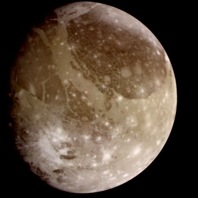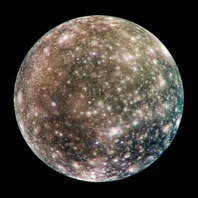



|

|

Comet impacts explain Ganymede-Callisto dichotomy
DR EMILY BALDWIN
ASTRONOMY NOW
Posted: 25 January 2010


Planetary scientists have long pondered the reasons for the vastly different surface and interior states of the outer Galilean satellites Ganymede and Callisto, but new research suggests that differences in the number and speed of cometary impacts could be to blame.
  Ganymede (left) and Callisto (right) as seen by the Galileo spacecraft. New research explains the surprising differences between the two moons. Images: NASA/JPL/DLR. Ganymede (left) and Callisto (right) as seen by the Galileo spacecraft. New research explains the surprising differences between the two moons. Images: NASA/JPL/DLR.
At first glance the two giant Jovian moons seem fairly similar – they are both a similar size (Ganymede is the largest moon in the Solar System at 5,260 kilometres across; Callisto measures 4,820 kilometres wide) and both made of rock and ice with craters littering their surfaces. This is especially true of Callisto, which has an extremely heavily cratered, ancient surface. In contrast, Ganymede shows signs of tectonic activity, with light regions cut with grooves and ridges overlying patches of a much older, more heavily cratered, darker surface.
It is speculated that Ganymede has a liquid, iron-rich core responsible for driving its magnetic field (Ganymede is the only moon in the Solar System to have its own magnetic field) with perhaps a saltwater ocean within 200 kilometres of its surface. Callisto may also harbour a thin ocean, but its interior is much less differentiated than Ganymede's – that is, it hasn't separated out into compositionally distinct layers.
 Interior density structures created by an outer Solar System late heavy bombardment onto Ganymede (top row) and Callisto (bottom row). The left column shows the density at the surface as a function of latitude and longitude, and the right column shows a slice through the centre of the globe. Colours show the density, with black representing pure rock, blue representing mixed ice and rock, and white showing pure ice. Image: Southwest Research Institute. Interior density structures created by an outer Solar System late heavy bombardment onto Ganymede (top row) and Callisto (bottom row). The left column shows the density at the surface as a function of latitude and longitude, and the right column shows a slice through the centre of the globe. Colours show the density, with black representing pure rock, blue representing mixed ice and rock, and white showing pure ice. Image: Southwest Research Institute.
In a paper published in the 24 January issue of Nature Geoscience, Amy Barr and Robin Canup of the Southwest Research Institute Planetary Science Directorate describe a new model that offers a solution as to why two moons born in the same neighbourhood have grown up so differently. Their model looks at how the moons' evolutionary paths are influenced by impacts from comets early in their history, and find that their paths diverged about 3.8 billion years ago, during the same period of time – the Late Heavy Bombardment Era – when large impact basins were formed on our own Moon.
“Impacts during this period melted Ganymede so thoroughly and deeply that the heat could not be quickly removed. All of Ganymede’s rock sank to its centre the same way that all the chocolate chips sink to the bottom of a melted carton of ice cream,” says Barr. “Callisto received fewer impacts at lower velocities and avoided complete melting.”
A movie showing the evolution of Ganymede (bottom) and Callisto's (top) surfaces and interiors. Colours indicate density, with black showing rock, blue showing mixed ice and rock, and lighter shades of blue indicating a decreasing rock fraction. The surfaces are initially blue, indicating a uniform ice/rock mixture. Each frame of the movie records 50 new impacts onto each moon. Callisto receives 2,600 impacts, but Ganymede receives 5,200. When the late heavy bombardment on Callisto is complete, the movie of Callisto stops, but Ganymede continues to experience an additional 2,600 impacts (so the movie of its evolution has more frames) which leads to a larger core on Ganymede than Callisto. Credit: Southwest Research Institute.
The variation in the number and energy of impacts at the two moons can be blamed on Jupiter – it's strong gravitational influence drawing twice as many comets towards nearer Ganymede at higher speeds than at Callisto. Every time the moons receives a strike, the energy from the impact melts portions of the ice-rock surface. Over time, repeated overlapping impacts remove all of the rock from the moons’ outer layers; the rocky component sinks towards the moon's centre to form a core. The models reveal that this process of core formation becomes energetically self-sustaining in Ganymede but not Callisto, which explains why Ganymede's interior is more evolved.
“Similar to Earth and Venus, Ganymede and Callisto are twins, and understanding how they were born the same and grew up to be so different is of tremendous interest to planetary scientists,” says Barr. “Our study shows that Ganymede and Callisto record the fingerprints of the early evolution of the Solar System, which is very exciting and not at all expected.”
|

|

|

|
|



